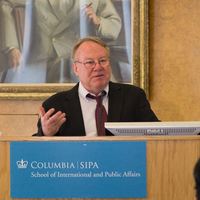
James R . Fleming
James Rodger Fleming (Ph.D. history, Princeton University) is the Charles A. Dana Professor Emeritus of Science, Technology, and Society at Colby College, Maine. He is a fellow of the American Association for the Advancement of Science (AAAS) and the American Meteorological Society (AMS), series editor of Palgrave Studies in the History of Science and Technology, and contributing author to the Intergovernmental Panel on Climate Change. Jim’s books include Meteorology in America, 1800-1870 (Johns Hopkins University Press, 1990), Historical Perspectives on Climate Change (Oxford University Press, 1998), The Callendar Effect (AMS Books, 2007), Fixing the Sky: The checkered history of weather and climate control (Columbia University Press, 2010)—winner of the 2011 Sally Hacker Prize from the Society for the History of Technology and the Louis J. Battan Author’s Award from the AMS -- Inventing Atmospheric Science (The MIT Press, 2016), and FIRST WOMAN: Joanne Simpson and the Tropical Atmosphere (Oxford University Press, 2020), He is currently involved in research on Big History: Critique and counterproposal.
Please visit my Colby profile page for the most up-to-date information:
http://www.colby.edu/profile/jfleming/
Please visit my Colby profile page for the most up-to-date information:
http://www.colby.edu/profile/jfleming/
less
InterestsView All (12)
Uploads
Books by James R . Fleming
James Rodger Fleming
REVISED EDITION 1997
Originally issued as NCAR/TN-327-IA.
Boulder, Colo.: National Center for Atmospheric Research, 1989.
Original NTIS document number PB 89159206.
Editions by James R . Fleming
Papers by James R . Fleming
James Rodger Fleming
REVISED EDITION 1997
Originally issued as NCAR/TN-327-IA.
Boulder, Colo.: National Center for Atmospheric Research, 1989.
Original NTIS document number PB 89159206.
James Rodger Fleming
Colby College
“The cumulus cloud is the queen of beauty in the realm of the atmosphere”
—Herbert Riehl
This presentation, based on the life and work of Joanne (Gerould) Simpson (1923-2010), charts the history of women in meteorology and the history of tropical meteorology in the context of her long and productive career as pioneer scientist, project leader, and mentor.
In 1943 women had no status in meteorology, tropical weather was largely aer incognita, and Joanne Gerould, a new graduate student at the University of Chicago, had just set her sights on understanding the behavior of clouds. Establishing her career in an era of overwhelming marginalization of women in science was no easy matter, and Joanne (who published under three married names and raised three children) had to fight every step of the way. Under the mentorship of Herbert Riehl, she received a Ph.D. from Chicago in 1949. Later, while working at Woods Hole, she collaborated with Riehl on their revolutionary and controversial "hot tower" hypothesis that cumulonimbus clouds were the driving force in the tropical atmosphere, providing energy to power the Hadley circulation, the trade winds, and by implication, the global circulation.
The mechanism of hot towers alludes to the incessant battle between buoyancy and entrainment in tropical convection, valorizing those clouds that successfully break through the trade wind inversion to soar to the top of the troposphere. The metaphor of hot towers points to the incessant battles Joanne waged between her sky-high aspirations and the dark psychological and institutional forces dragging her down. Yet she prevailed, reaching the pinnacle of personal and professional accomplishment, especially in her years at NASA, as she conditioned the atmosphere for further breakthroughs for women in science.